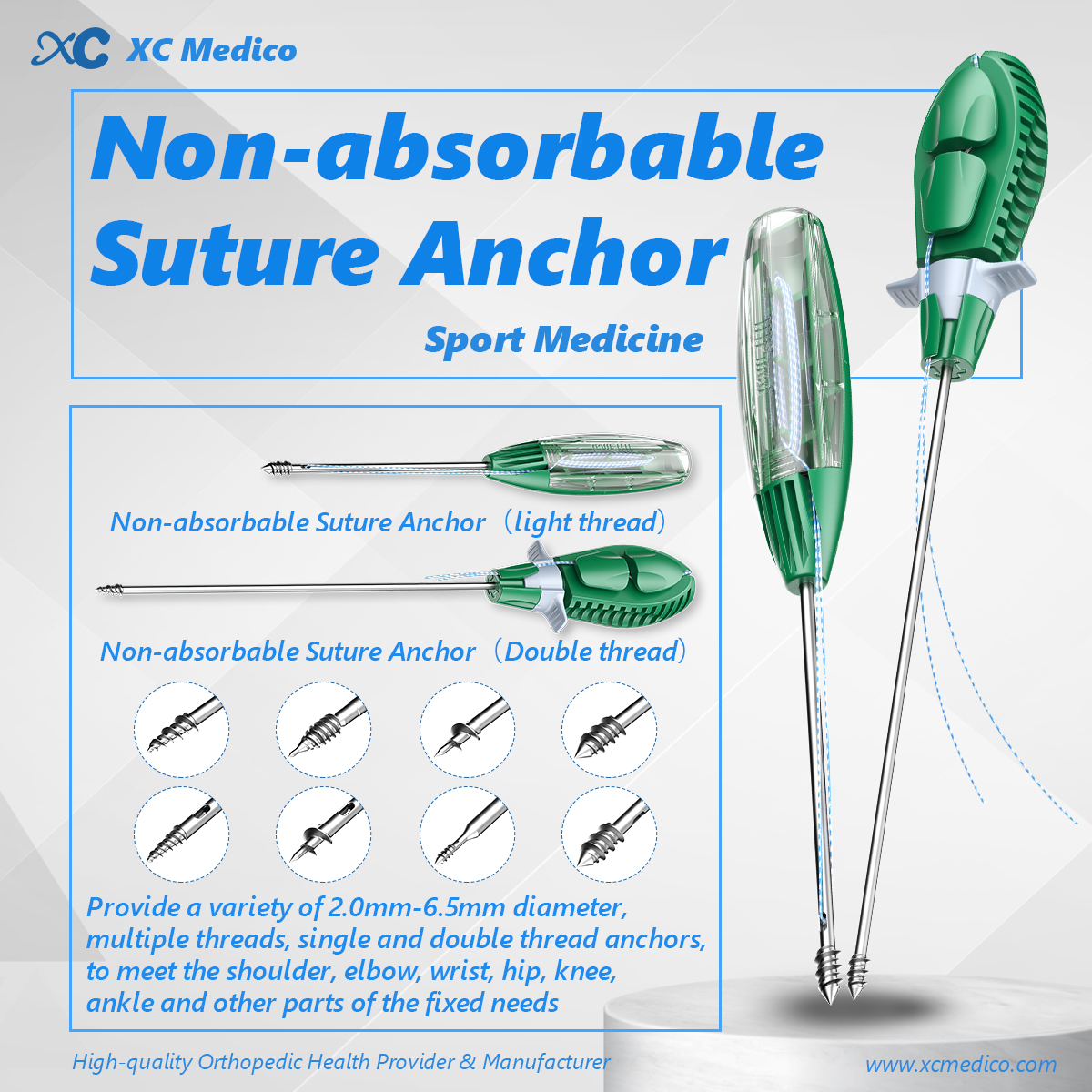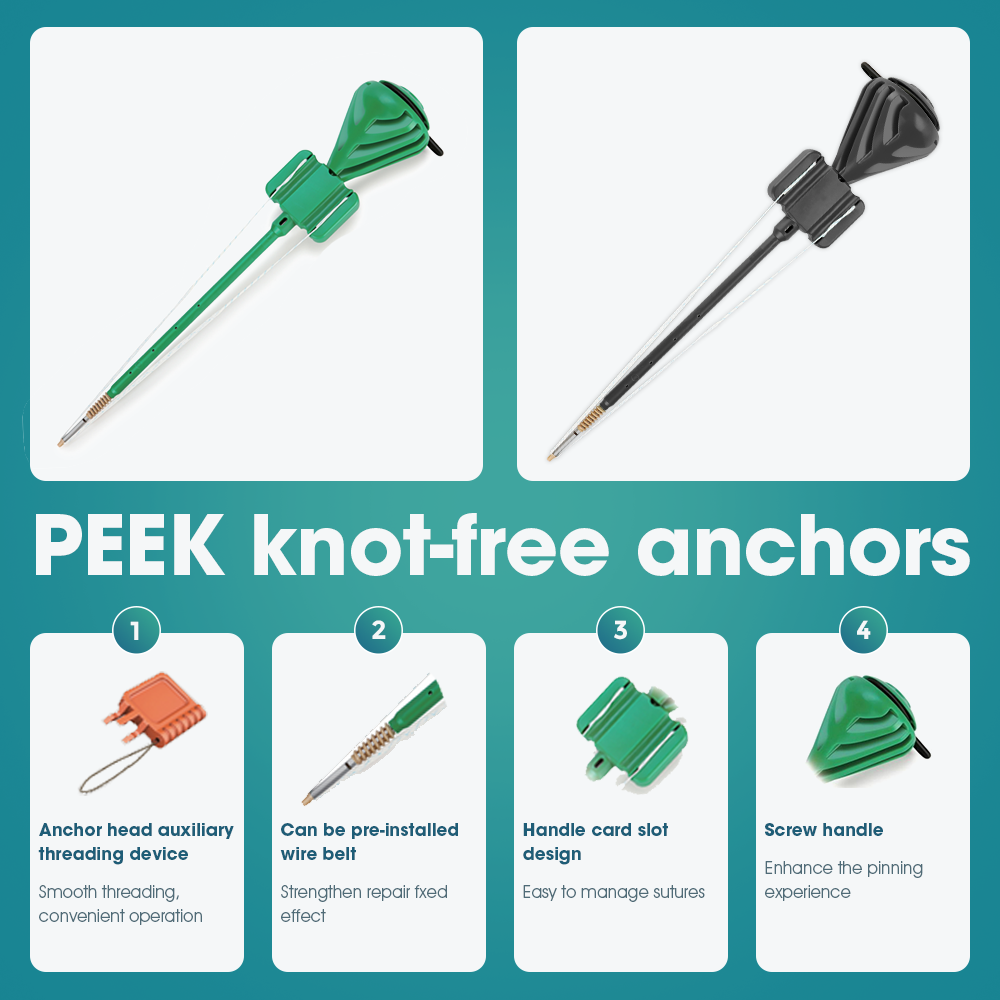Introduction
If you’ve ever torn your rotator cuff, you know how life-disrupting it can be. Whether you're a competitive athlete, a weekend warrior, or someone who just reached for something awkwardly, rotator cuff injuries are no joke. Fortunately, modern orthopedic surgery offers powerful solutions to restore shoulder function—chief among them being the use of suture anchors. But here’s
Overview of Metal Suture Anchors

Metal anchors have been around since the early days of arthroscopy. Typically made from titanium or stainless steel, they are valued for:
Superior strength and rigidity
Proven track record of success
Excellent fixation, especially in osteoporotic bone
However, their metallic nature does come with downsides:
X-ray and MRI artifacts, which obscure imaging
Difficulty during revision surgery, since they are permanent
Potential for migration or damage to cartilage
They are available in various sizes and threading styles to match different surgical needs.
Overview of PEEK Suture Anchors

PEEK, or polyetheretherketone, is a non-metallic thermoplastic that has surged in popularity due to its biomechanical and chemical stability. Originally used in spinal implants, it has made its way into sports medicine due to advantages like:
Radiolucency (no imaging interference)
Strong yet flexible biomechanical profile
Biocompatibility with bone and soft tissue
Surgeons often report easier reentry and better visibility with PEEK anchors, particularly for post-op evaluations.
Mechanical Performance Comparison
When it comes to pullout strength, torsional stability, and suture retention, both anchor types perform admirably. However:
Metal anchors typically exhibit higher tensile strength due to their rigidity.
PEEK anchors often match or exceed metal anchors in clinical trials due to advanced thread designs and polymer elasticity.
PEEK also reduces the stress concentration at the anchor-bone interface, potentially minimizing microfractures in delicate bone.
Imaging and Radiographic Visibility
One of the biggest selling points for PEEK? No imaging distortion.
Metal anchors create artifacts in MRIs and CT scans, which can obscure soft tissue healing and make diagnostics harder.
PEEK anchors are radiolucent, allowing for clear follow-up imaging.
This is particularly important for athletes, where precise healing monitoring is essential before returning to high-level activity.
Biocompatibility and Biological Response
Both materials are biocompatible, but in different ways.
Metal anchors are inert but permanent; they may not integrate with bone.
PEEK anchors are also inert, but some variants are textured or coated to promote osseointegration (bone growth into the anchor).
Additionally, PEEK avoids risks of metal allergies, which affect 10–15% of the population.
Handling and Intraoperative Feedback
Surgeons love what they can feel.
Metal anchors provide a solid "bite" into bone and are familiar to many surgeons trained on them.
PEEK anchors are lighter, with a slightly different tactile response, but newer models mimic the tactile feedback of metal anchors effectively.
Insertion torque, fixation reliability, and depth control are all critical—and PEEK is catching up fast.
Longevity and Durability in Vivo
Both materials are designed to last decades. However:
There’s no sign of PEEK fatigue failure under typical shoulder loads—even after years.
Reoperation and Revision Surgery
This is where PEEK wins hands down.
Metal anchors can be difficult to remove or work around. Their artifacts complicate imaging and planning.
PEEK anchors, thanks to their radiolucency and non-integrated profile, are often easier to revise.
For young patients or high-risk cases, easier revision is a big deal.
Cost Comparison and Economic Factors
Metal anchors are generally cheaper per unit.
PEEK anchors are more expensive, but may reduce costs in other areas, such as imaging, revision surgery, and operation time.
So while PEEK might sting the budget initially, it can save downstream costs.
Patient Outcomes and Satisfaction
Studies show no significant difference in healing rates or re-tears between the two anchor types.
However, patients with PEEK anchors often report less postoperative imaging frustration, and in some cases, better shoulder mobility, likely due to less inflammatory response.
Surgeon Preferences and Global Trends
In North America and Europe, PEEK is gaining momentum fast.
In Asia and South America, metal anchors are still more commonly used due to price sensitivity.
That said, many top-tier hospitals are switching to PEEK as part of modernized surgical protocols.
Case Studies and Clinical Trials
A 2023 meta-analysis of 15 RCTs showed:
PEEK and metal anchors had similar failure rates
PEEK had better MRI clarity
Revision surgeries were faster and cleaner with PEEK
One notable study from Japan found PEEK anchors reduced operating time by an average of 12 minutes per case.
Environmental and Regulatory Considerations
Both materials are FDA-approved, CE-marked, and widely accepted in surgical guidelines.
Technological Innovation in Anchor Design
PEEK anchors are part of a new wave of innovation:
Bioactive coatings to promote healing
3D printed lattice structures for better bone ingrowth
Knotless PEEK anchors that simplify suturing
Metal anchors are also evolving, but PEEK’s versatility in design gives it an edge.
When to Use Metal Anchors
Metal anchors are still highly relevant, especially for:
Patients with poor bone quality where high mechanical strength is needed
Surgeries with budget constraints
Surgeons who require maximum tactile feedback
When to Use PEEK Anchors
PEEK anchors shine in:
Young or athletic patients who may need revision later
Situations requiring clean postoperative imaging
Surgeons using knotless techniques or advanced arthroscopy
Real Talk: Pros and Cons Recap
| Feature | Metal Anchors | PEEK Anchors |
| Strength | ✅✅✅ | ✅✅ |
| Imaging Clarity | ❌ | ✅✅✅ |
| Revision Friendly | ❌ | ✅✅✅ |
| Cost | ✅✅✅ | ❌❌ |
| Osseointegration | ❌ | ✅✅ |
| Tactile Feedback | ✅✅✅ | ✅✅ |
Surgeon and Patient Testimonials
“Once I switched to PEEK anchors, I never looked back. Clear imaging and smoother surgeries make it worth every cent.” — Dr. Harris, Orthopedic Surgeon, NY
“I was worried about having metal inside my body. My doctor chose PEEK, and my recovery has been smooth and fast.” — Alex, 38, Tennis Player
Frequently Asked Questions (FAQs)
Q: Can PEEK anchors break inside the body?
A: Highly unlikely. PEEK is incredibly strong and designed to withstand shoulder loads.
Q: Will metal anchors affect airport security or MRIs?
A: They won’t set off alarms, but they can interfere with MRI quality.
Q: Is PEEK biodegradable?
A: No, PEEK is a permanent implant like metal, but biologically inert.
The Future of Suture Anchors in Sports Medicine
As surgical techniques become more precise and personalized, anchor choice will continue to evolve. Expect more hybrid anchors, biologically enhanced PEEK designs, and AI-assisted placement in the near future.
Final Verdict: Which One Wins?
There’s no one-size-fits-all answer—but for most modern rotator cuff repairs, PEEK anchors offer a compelling combination of clarity, biocompatibility, and future-proofing.
Conclusion
Suture anchors may be small, but their impact is massive. Whether you’re a surgeon choosing tools, or a patient researching your options, understanding the difference between metal and PEEK anchors could mean the difference between a smooth recovery and months of frustration.
PEEK may not be the cheapest, but in many ways, it’s the smartest long-term investment for rotator cuff repair.
English
Русский
简体中文
繁體中文
العربية
Français
Español
Português
Deutsch
italiano
日本語
한국어
Nederlands
Tiếng Việt
ไทย
Polski
Türkçe
አማርኛ
ພາສາລາວ
ភាសាខ្មែរ
Bahasa Melayu
ဗမာစာ
தமிழ்
Filipino
Bahasa Indonesia
magyar
Română
Čeština
Монгол
қазақ
Српски
हिन्दी
فارسی
Kiswahili
Slovenčina
Slovenščina
Norsk
Svenska
українська
Ελληνικά
Suomi
Հայերեն
עברית
Latine
Dansk
اردو
Shqip
বাংলা
Hrvatski
Afrikaans
Gaeilge
Eesti keel
Māori
සිංහල
नेपाली
Oʻzbekcha
latviešu
অসমীয়া
Aymara
Azərbaycan dili
Bamanankan
Euskara
Беларуская мова
भोजपुरी
Bosanski
Български
Català
Cebuano
Corsu
ދިވެހި
डोग्रिड ने दी
Esperanto
Eʋegbe
Frysk
Galego
ქართული
guarani
ગુજરાતી
Kreyòl ayisyen
Hausa
ʻŌlelo Hawaiʻi
Hmoob
íslenska
Igbo
Ilocano
Basa Jawa
ಕನ್ನಡ
Kinyarwanda
गोंगेन हें नांव
Krio we dɛn kɔl Krio
Kurdî
Kurdî
Кыргызча
Lingala
Lietuvių
Oluganda
Lëtzebuergesch
Македонски
मैथिली
Malagasy
മലയാളം
Malti
मराठी
ꯃꯦꯇꯥꯏ (ꯃꯅꯤꯄꯨꯔꯤ) ꯴.
Mizo tawng
Chichewa
ଓଡ଼ିଆ
Afaan Oromoo
پښتو
ਪੰਜਾਬੀ
Runasimi
Gagana Samoa
संस्कृत
Gaelo Albannach
Sepeti
Sesotho
chiShona
سنڌي
Soomaali
Basa Sunda
Wikang Tagalog
Тоҷикӣ
Татарча
తెలుగు
ትግንያውያን
Xitsonga
Türkmençe
संस्कृत
ئۇيغۇرچە
Cymraeg
isiXhosa
ייִדיש
Yorùbá
isiZulu





